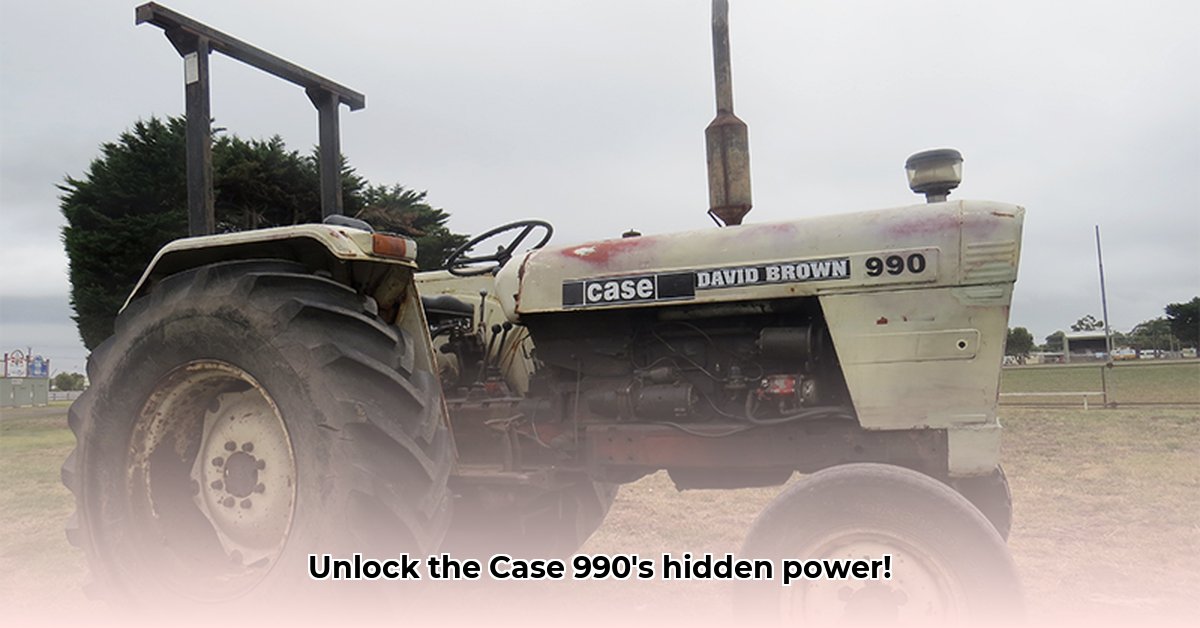
The J.I. Case 990 tractor, produced between 1976 and 1980, represents a significant chapter in agricultural history, inheriting the robust engineering legacy of David Brown. This comprehensive guide delves into the tractor's specifications, operation, maintenance, and collector value, offering insights for enthusiasts, historians, and potential restorers. For comparison, see specs on other classic tractors like the Ford 9N.
Technical Specifications: A Detailed Overview
The Case 990's power comes from a David Brown 3.2-liter, four-cylinder diesel engine, generally delivering around 58 net horsepower. However, reported horsepower figures can vary slightly due to differences in testing methodologies employed at the time. This engine's precise specifications, including bore, stroke, and compression ratio, provide a detailed view of its inner workings. How did this power output compare to competitors like John Deere or Ford models of the same era? Further research could provide a definitive answer. The engine's performance in various conditions and its fuel efficiency remain interesting points of study for those seeking deeper understanding. The tractor's overall build showcases the engineering sophistication of the era. The specifications table further details the tractor's key characteristics.
Powertrain and Operational Aspects
The Case 990's 12-speed Selectamatic transmission was revolutionary for its partial synchronization, resulting in smoother shifting compared to its predecessors. This feature significantly enhanced the operator's comfort during long working hours. However, the ease-of-use likely varied depending on the operator's experience. The open-center hydraulic system powered steering and implements, offering efficient operation for the era's implements. The availability of a Live PTO (Power Take-Off) allowed for greater flexibility in agricultural operations. How did this transmission's performance compare to similar transmissions in other tractors of the time? A comparative study would add valuable context to the 990's capabilities.
Dimensions, Weight, and Build
The Case 990's sturdy build was reflected in its weight, ranging from approximately 5760 to 6700 pounds, depending on configuration and options. This variation underscores the lack of uniformity in reporting these specifics historically. Though dimensions aren't universally consistent across sources, they generally adhere to the standard range for tractors of this size and class. This robust construction, combined with its powerful engine, made it capable of handling diverse tasks and challenging soil conditions. What's the significance of these weight variations, and do they reflect intentional design choices or manufacturing tolerances? Further investigation is needed to fully understand these nuances.
| Specification | Value (Approximate) | Notes |
|---|---|---|
| Engine | 58 hp (net) | Variations due to testing methodology differences |
| Transmission | 12-speed Selectamatic | Partially synchronized, smoother shifting than predecessors |
| Hydraulic System | Open-center | Efficient for implements of the time |
| Rear Hitch | Category II/I | Compatible with a range of implements |
| PTO | Live PTO (optional) | Enhanced flexibility for power-driven attachments |
| Weight | 5760-6700 lbs | Variations due to configuration and options |
| Fuel Tank Capacity | 17.9 gallons | Approximately 67.8 liters |
Maintenance and Restoration: A Practical Guide
Maintaining or restoring a Case 990 requires dedication and careful planning. Sourcing parts can be challenging, highlighting the importance of connecting with online communities and specialist suppliers. Preventative maintenance, including regular lubrication, oil changes, and thorough inspections, is paramount. Safety precautions, particularly when working with the PTO and hydraulic system, are crucial. Why are certain parts particularly difficult to source for this model, and what strategies are most effective in locating them? Additional research could enhance the restoration advice provided in this guide.
Market Context and Value: A Collector's Perspective
The Case 990 holds significant appeal for collectors and agricultural history enthusiasts. Its robust design, historical significance, and connection to the David Brown heritage contribute to its desirability. Market value varies considerably depending on its condition, originality, and accompanying documentation. What specific features do collectors consider most valuable, and how do these factors influence the final price? This aspect deserves further research to provide a more accurate picture of its collector market.
Addressing Inconsistencies in Reported Specifications
Minor discrepancies in reported power output and other specs highlight the challenges inherent in researching vintage machinery with potentially incomplete or inconsistent documentation. These variations most likely result from differences in measuring techniques or rounding of figures. The absence of comprehensive comparisons with contemporary competitors makes it difficult to definitively assess the 990's market position during its production years. Further research is needed to bridge these informational gaps and provide a more comprehensive and precise understanding of the machinery.
Conclusion: A Legacy of Power and Precision
The J.I. Case 990, a product of its time, continues to resonate with enthusiasts today. Its blend of robust design, innovative features, and historical relevance makes it a compelling subject for study. Whether you're a collector, mechanic, or historian, understanding the specifications and operational aspects of this powerful tractor provides a valuable glimpse into the past and the evolution of agricultural technology.